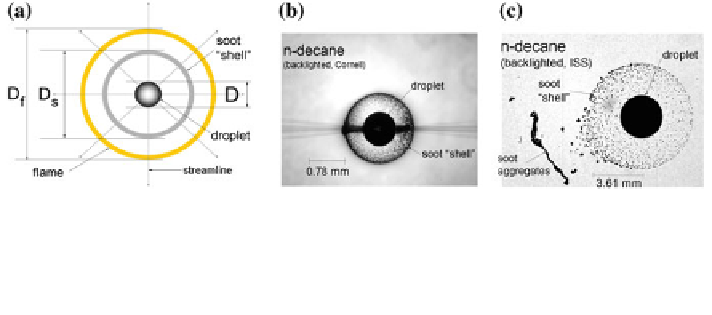Environmental Engineering Reference
In-Depth Information
Fig. 4 a Schematic representation of an isolated droplet burning with spherical symmetry.
b Backlighted photograph of a
”
fiber-supported n-decane droplet burning in the standard
atmosphere at normal atmospheric pressure and showing the soot shell; c
“
small
free or
unsupported n-decane droplet burning in the MDCA of the International Space Station in the
standard atmosphere
“
large
”
guration for developing
surrogates has been recognized. The principle advantage is that detailed numerical
modeling can be applied,
The attractiveness of a low-dimensional transport con
thereby allowing a rigorous test of the combustion
kinetics. For example, con
gurations have included shock tubes and rapid com-
pression machines (Gauthier et al.
2004
; Yahyaoui et al.
2007
; Werler et al.
2014
),
counter
flames and jet-stirred reactors (Choi et al.
2011
; Dagaut et al.
2008
),
and premixed and non-premixed
fl
ow
fl
flow reactors (Chaos et al.
2007
; Bieleveld et al.
2009
), among others. They require that the fuel be pre-vaporized before entering the
combustion zone. Pre-vaporization eliminates the intimate relationship between fuel
vaporization and multicomponent effects for sustaining the
fl
fl
flame that is intrinsic to
the combustion of sprays and droplets in engines.
With liquid fuel injection comes evaporation and moving boundary effects; the
con
guration of Fig.
4
incorporates these processes. Phase equilibrium of the fuel
determines the evaporation rate of liquid in a spray; and the temperature of an
isolated droplet is also controlled by this process. Unsteady gas and liquid transport,
soot formation, and radiation are intrinsic to in-cylinder processes in which the
con
guration of Fig.
4
also includes. The isolated droplet case incorporates these
aspects as a natural consequence of the burning process. There is also carryover of
such aspects as soot morphology and combustion chemistry of the base case of
Fig.
4
to the more complex conditions of an engine. As such, the combustion
symmetry of an isolated droplet burning with no convective effects is considered to
be an appropriate platform for developing combustion properties for developing
surrogate fuels.
It is also worth-mentioning that developing surrogates from the perspective of
individual droplets is attractive for the very small liquid volumes needed for droplet
combustion experimentation. In spray or engine tests, tens of gallons are typically
required to evaluate performance. New fuel blends can be in short supply (e.g.,
algal biodiesel) with the availability of a suf
cient fuel supply limiting the range of
conditions that can be evaluated in experiments. On the other hand, droplet com-
bustion experiments utilize very small volumes, on the order of 10
−
8
gallons per
burning event, and will not be restricted by this concern.

Search WWH ::

Custom Search